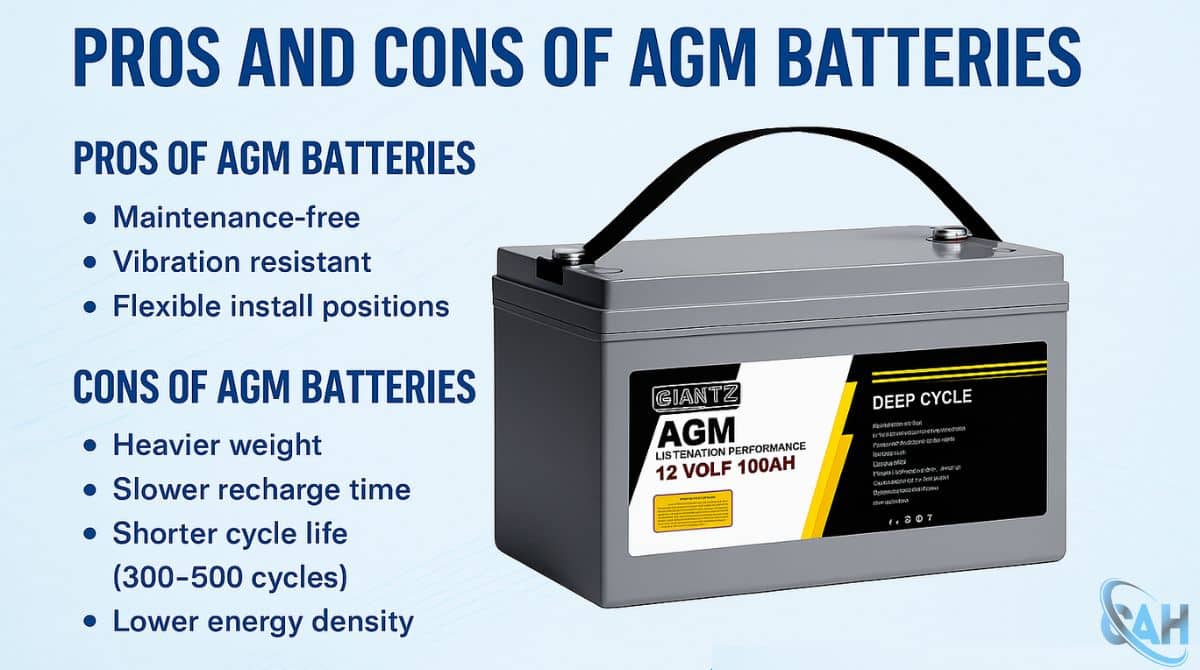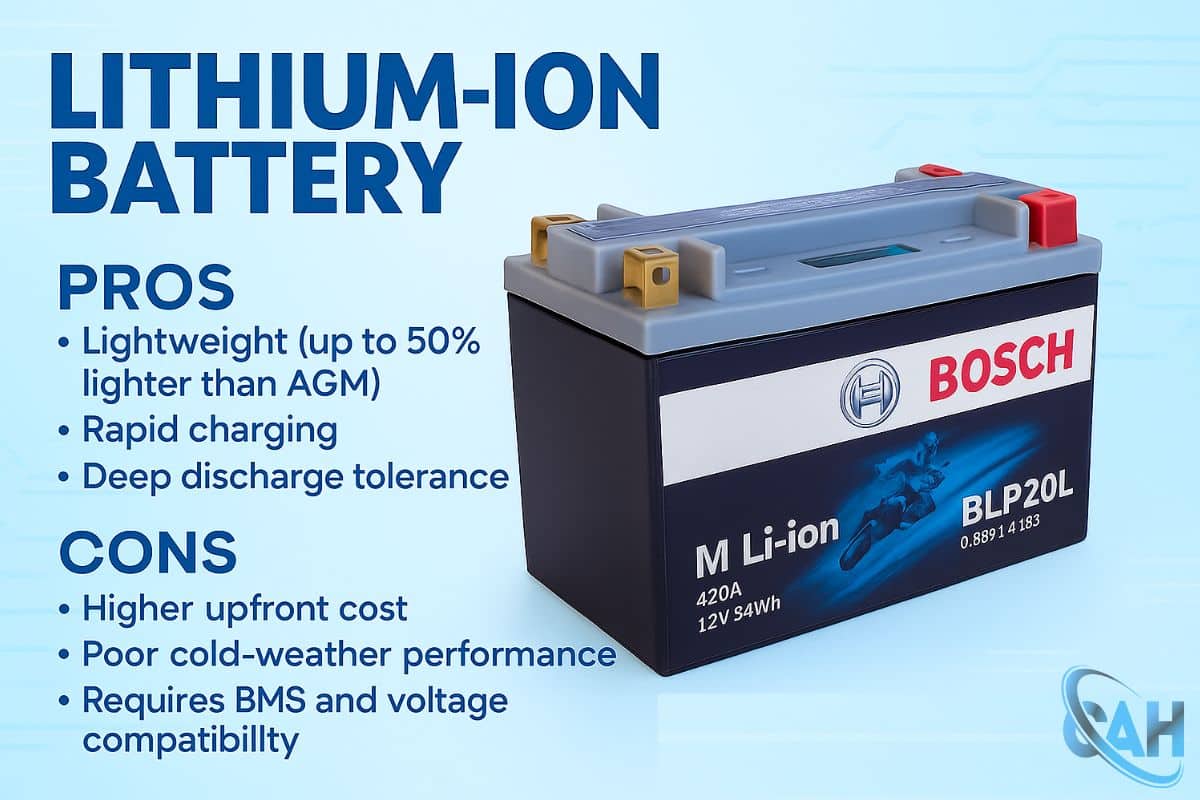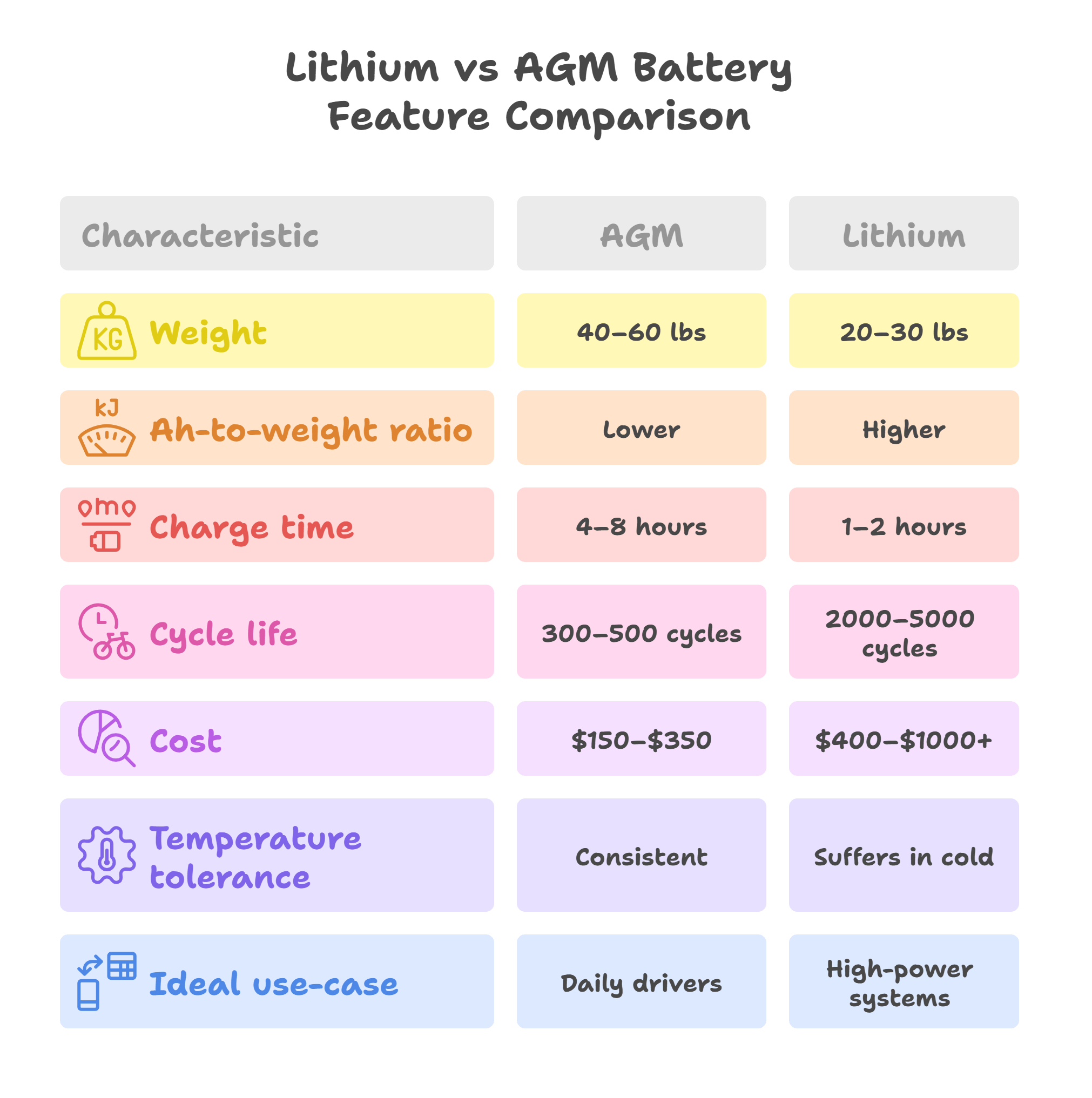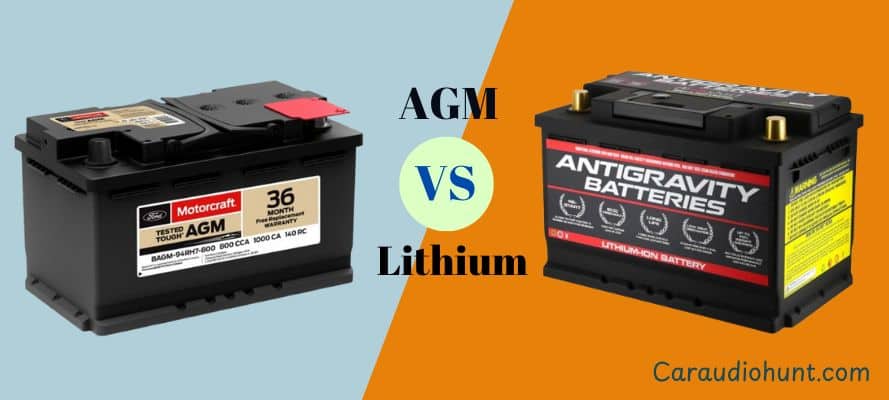Over the years, I’ve seen how much impact the right battery can have on a car audio setup. Whether it’s eliminating voltage drops during bass hits or powering a 3000W amp without breaking a sweat, your battery choice matters more than most people think.
And that brings us to one of the most debated topics I get asked about lithium vs AGM car battery. In high-output systems, where your power demands are anything but average, picking between these two isn’t just about price. It’s about long-term performance, safety, and how your system actually behaves under load.
In this guide, I’ll break down the differences I’ve come across between lithium and AGM batteries for car audio relied on real installs, not theory. From charge times and weight to cycle life and cold-weather reliability, let’s see which one truly fits your system best.
In This Article
- What Is an AGM Battery and Its Strengths and Weakness?
- What Is a Lithium Battery and Its Strengths and Weakness?
- AGM vs Lithium - Side-by-Side Comparison Table
- Lithium vs AGM Battery's Feature Comparisons with Verdicts
- Real-World Use Cases – Which Battery Wins When?
- Common Myths about Lithium vs AGM
- Frequently Asked Questions
- Can I leave a lithium-ion battery in my car?
- What is the lifespan of a lithium battery for a car?
- How much does it cost to replace a lithium battery in a car?
- When should you not use lithium batteries?
- What is the biggest problem with lithium batteries?
- What is the downside of AGM batteries?
- How many batteries do I need for a 3000 watt amplifier?
- Is it okay to put an AGM battery in a car?
- What’s the difference between AGM and lithium car battery?
- Can I replace AGM with lithium in my car audio?
- How many cycles do AGM vs lithium batteries last?
- Is AGM battery outdated?
- Is a lithium battery safe for car audio?
- Will a lithium battery work in cold weather car audio?
- What type of battery is best as a secondary for car audio?
- Final Verdict – AGM or Lithium?
What Is an AGM Battery and Its Strengths and Weakness?
AGM stands for Absorbent Glass Mat, a sealed lead-acid battery design that uses glass fiber mats to hold the electrolyte solution. This eliminates the need for free liquid acid, making AGMs spill-proof and maintenance-free.
AGM batteries have long been the standard in car audio for their affordability, durability, and ability to handle moderate power needs. They’ve been reliable as secondary batteries in daily driver builds where space and mounting angle come into play.

Pros and Cons of AGM Battery
Key Pros of AGM batteries
Cons to keep in mind
What Is a Lithium Battery and Its Strengths and Weakness?
Lithium batteries used in car audio are typically Lithium Iron Phosphate (LiFePO4), which are safer and more stable than traditional lithium-ion chemistries.
LiFePO4 batteries have surged in popularity thanks to their deep cycling capabilities, ultra-fast charging, and superior energy-to-weight ratio. Personally, I’ve found them especially effective in competition setups or systems exceeding 2000W RMS.

Pros and Cons of Lithium-Ion Battery
Key Pros of lithium batteries
Cons to keep in mind
AGM vs Lithium - Side-by-Side Comparison Table
To help you decide based on what I’ve seen in real builds, let’s break down the key features, compare how AGM and lithium perform, and call a clear winner for car audio.
Each feature below directly affects system performance. This side-by-side chart shows where each battery type shines, making it easier to weigh your options.
Feature | AGM | Lithium |
|---|---|---|
Weight | 40–60 lbs | 20–30 lbs |
Ah-to-weight ratio | Moderate | High |
Charge time | 4–8 hours | 1–2 hours |
Cycle life | 300–500 cycles | 2000–5000 cycles |
Cost | Lower | Higher |
Temperature tolerance | Excellent in cold temps | Poor below 32°F (0°C) |
Ideal use-case | Budget daily drivers | High-performance or show builds |
Lithium vs AGM Battery's Feature Comparisons with Verdicts
After going through the comparison table, I'll now evaluate features of both types of batteries with my verdict for each feature. Let’s dive in.
Weight
AGM batteries can weigh between 40–60 lbs, while lithium batteries typically fall between 20–30 lbs. In tight installs or competition builds, the reduced weight of lithium means easier mounting and less stress on your vehicle.
Ah-to-weight ratio
Lithium batteries deliver significantly more amp-hours per pound compared to AGM. This translates to higher energy efficiency and better performance in the same physical footprint.
Charge time
AGM batteries usually take 4–8 hours to fully recharge, depending on the charger. Lithium batteries can recharge in just 1–2 hours thanks to higher charge acceptance rates.
Cycle life
Most AGM batteries are rated for 300–500 full cycles. Lithium batteries, especially LiFePO4, offer 2000–5000 cycles. Over time, this translates to longer service life and better cost-per-cycle.
Cost
AGM batteries typically cost less upfront ($150–$350), whereas lithium batteries can range from $400–$1000+. However, lithium offers longer lifespan and better long-term ROI in demanding setups.
Temperature tolerance
AGM performs consistently even in sub-zero conditions. Lithium batteries often suffer in cold environments, requiring temperature-regulated charging systems.
Ideal use-case
AGM excels in daily drivers and budget setups. Lithium is better for systems over 2000W RMS, SPL competitors, and off-grid show rigs.

Lithium vs AGM Battery Features Comparison Diagram
Real-World Use Cases – Which Battery Wins When?
In real builds I’ve come across, lithium takes the lead when performance is pushed hard in competition setups. But AGM still holds its ground for budget-friendly systems, cold-weather installs, and daily drivers that don’t need extreme output.
What sounds good on paper doesn’t always match the real deal. So here’s how each battery actually holds up in the kinds of car audio setups most of us deal with.
- Scenario 1: For SPL and competition setups? Lithium wins. Its fast recovery and high discharge rate are ideal for amps pulling serious current.
- Scenario 2: For budget daily drivers? AGM is the better value. It's cheaper and requires no special setup.
- Scenario 3: For engine-off music sessions? Lithium again. You get more usable amp hours per charge.
- Scenario 4: For cold-weather installs? AGM shines. It delivers consistent performance even below freezing.
- Scenario 5: For trunk-mount installs? Both are safe, but lithium is significantly lighter and easier to work with.
Common Myths about Lithium vs AGM
Don’t fall for one-size-fits-all assumptions. Each battery type has distinct strengths and weakness that only make sense when matched to your actual system specs and usage patterns.
It’s easy to get caught up in the hype. Let’s bust a few persistent myths that cloud the decision-making process when choosing between AGM and lithium for car audio.
"Lithium always lasts longer." - True in terms of cycle count, but only if it's used within proper voltage and thermal limits.
"AGM is outdated." - Not at all. AGM remains ideal for many budget-conscious and cold-weather builds.
"You can swap to lithium with no setup change." - False. Lithium requires a proper BMS and sometimes a new charger or alternator setup.
Frequently Asked Questions
Over the years, I’ve been asked plenty of questions by audio enthusiasts comparing these two battery types for their cars. Below are some of the most common ones, which I’ll answer briefly to help you decide between AGM and lithium batteries. Let’s take a look.
Can I leave a lithium-ion battery in my car?
You can, but you should be cautious. High heat or freezing temperatures can degrade lithium batteries over time. If your system has a BMS and thermal protections, it’s safer.
What is the lifespan of a lithium battery for a car?
Lithium car batteries, especially LiFePO4 types, typically last between 2000 to 5000 charge cycles. That translates to 8–15 years depending on usage and system design.
How much does it cost to replace a lithium battery in a car?
Replacing a lithium car audio battery can cost anywhere from $300 to over $1000 depending on the amp-hour rating and brand quality.
When should you not use lithium batteries?
Avoid lithium batteries if your system operates in sub-zero environments or if you don’t have the right charging setup. AGM is safer in those cases.
What is the biggest problem with lithium batteries?
Thermal sensitivity. While efficient, lithium cells can fail or degrade quickly if overcharged, overheated, or used without a BMS.
What is the downside of AGM batteries?
AGM batteries are heavier, slower to charge, and have shorter cycle life compared to lithium alternatives.
How many batteries do I need for a 3000 watt amplifier?
Generally, one high-capacity lithium battery or two strong AGM batteries are required for a 3000W system. Always factor in alternator output and wire gauge.
Is it okay to put an AGM battery in a car?
Absolutely. AGM batteries are sealed, safe, and designed to work in most automotive systems without modification.
What’s the difference between AGM and lithium car battery?
AGM is a lead-acid design that’s heavier and cheaper, while lithium (LiFePO4) offers lighter weight, faster charging, and longer lifespan.
Can I replace AGM with lithium in my car audio?
You can, but make sure your system supports lithium charging profiles and has a compatible alternator and BMS.
How many cycles do AGM vs lithium batteries last?
AGM batteries average 300–500 cycles, while lithium batteries deliver 2000–5000 cycles, depending on conditions.
Is AGM battery outdated?
Not at all. AGM remains relevant for budget builds, cold climates, and users who don’t need the high output or deep cycling of lithium.
Is a lithium battery safe for car audio?
Yes, when paired with a proper Battery Management System. lithium battery is stable and widely used in audio competitions.
Will a lithium battery work in cold weather car audio?
It may struggle below 32°F. You’ll need a battery with built-in heating or temperature-regulated charging to ensure reliable performance.
What type of battery is best as a secondary for car audio?
Lithium is best for high-power systems due to fast recovery and longer cycle life. However, AGM is still a solid choice for moderate setups or users in colder climates due to its lower cost and cold-weather performance.
Final Verdict – AGM or Lithium?
Though I've explored everything you need to know to compare and choose between Lithium vs AGM Car Battery, it's still hard to get a universal winner, and I've learned that firsthand. Your battery choice should reflect your audio system's power draw, installation space, climate, and budget.
Match your battery to your system’s lifestyle, not just your budget.
Want to read more? Check Out These Guides:

